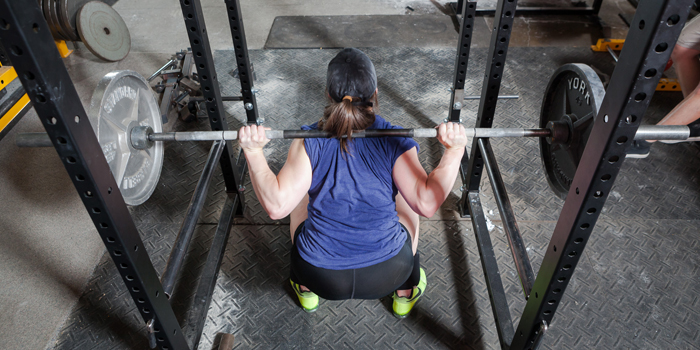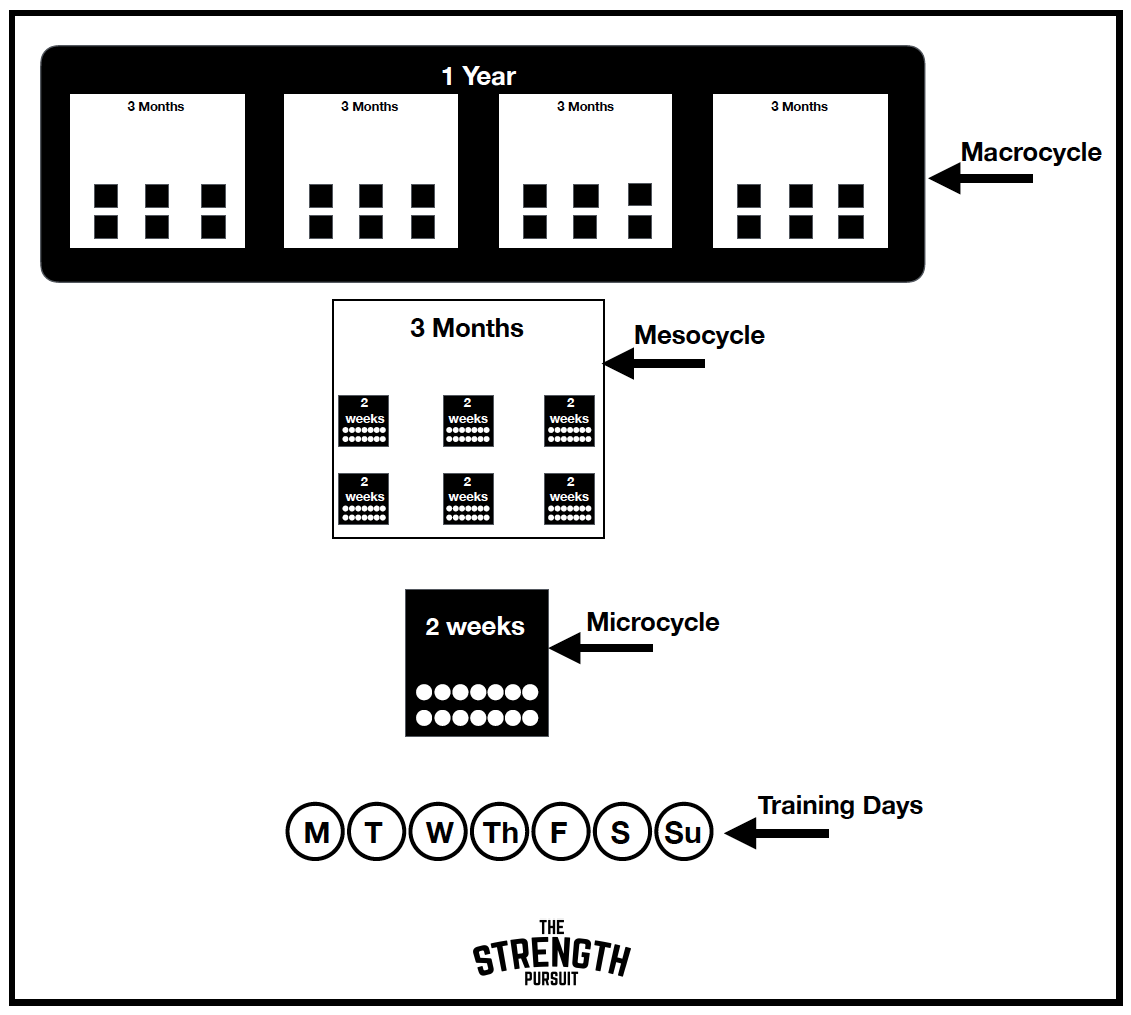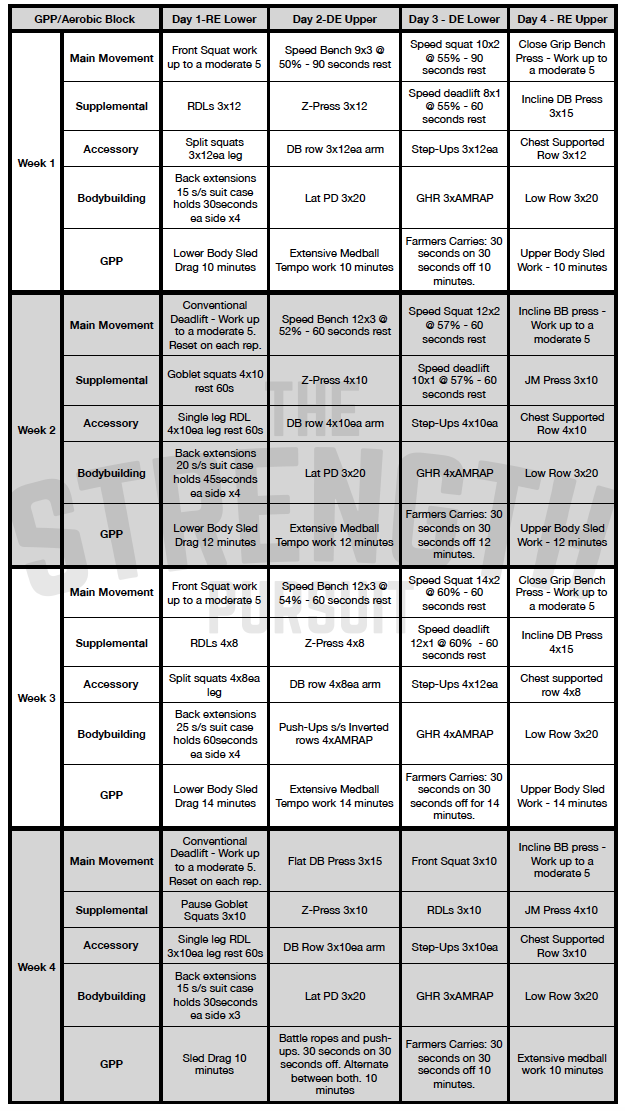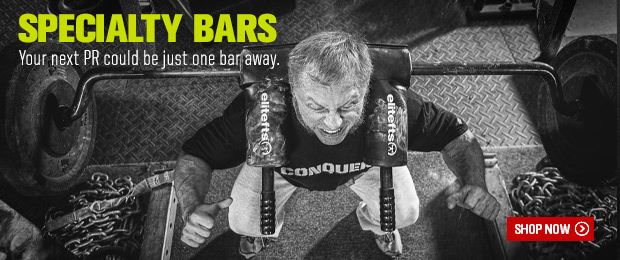
In the last article, I gave an introduction to what the conjugate sequence system was. It received a lot of positive feedback, and I can’t thank you enough for that, but I got a little pushback on it, which I expected.
The focus of this article is how to start developing a plan, how to lay out a hypothetical yearly plan, why powerlifters need GPP, and how I would set up the first month of training for a new client and why.
RECENT: The Beginner's Guide to the Conjugate Sequence System
Linear Versus Undulation Versus Conjugate
This needed to be said before I move on: Almost every single program and training system contains linear, undulation, and conjugate elements. Just because we are following a conjugate-based system doesn’t mean it won’t contain some type of linearity and undulation. Undulations are when we change the volume and/or intensity; linear is when we progress in a linear-style progression, and conjugation is when we train different characteristics at the same time.
Example:
Week 1
- Day 1: MEL — SSB Squat work up to 3RM
- Day 2: DEL — Speed Squats 10x2 @ 60% versus elitefts Pro Average Resistance Bands with 45-second rest
Week 2
- Day 1: MEL — SSB Squat work up to 2RM
- Day 2: DEL — Speed Squats 10x2 @ 62% versus average bands with 45-second rest
Week 3
- Day 1: MEL — SSB Squat work up to 1RM
- Day 2: DEL — Speed Squats 10x2 @ 64% versus average bands with 45-second rest
Week 4
- Day 1: MEL — SSB Squat work up to 3RM
- Day 2: DEL — Belt Squat 5x10
This is a very simplistic example, but as you can see, it has elements of all three. We have undulation as we change our volume and intensity with speed work weekly, but it also has a degree on linearity within it. Conjugation can be seen by the training of max effort and dynamic effort together.
Look at any program, and you will see elements of all three within the various levels of a program. These various levels are your different cycles: micro, meso, and macro. The microcycle is a single week; a mesocycle is a group of weeks ranging from two to twelve weeks; and the macrocycle is a collection of mesocycles. This is typically a year long.
We structure and divide training into various units. Everything that you do within your program has a specific objective. From the intensity to exercise selection to rest periods, they all have a purpose. The training units we use are hierarchical in nature and are as follows:
Needs Analysis of Powerlifting
Just like any other sport, we need to do a needs analysis. This is essentially specificity and allows us to plan out and write a program that is specific for the needs of your sport. In powerlifting, it’s to achieve the highest 1RM in the squat, bench, and deadlift, equating into the highest possible total at the end of a meet.
We need to ask questions like, “What are the energy system requirements for training? What are the skills needed? What motor abilities are required?”
Essentially, what do you need to perform at the highest level?
Physiological Analysis:
- A high amount of force, short distance, “low velocity”
- Strength primary
- Hypertrophy, power, and explosiveness secondary
Movement and Injury Analysis:
- Squat and deadlift in the sagittal plane
- Bench press in the transverse plane
- All major joints involved
- Major and common injuries include shoulder joint/rotator cuff, low back, elbows, and knee(s) most frequently injured. Many are chronic/overuse injuries. Muscle pulls and tendonitis appear to be the most common acute injuries.
Tests:
- Squat 1RM
- Bench 1RM
- Deadlift 1RM
The Annual Plan
Your training system should be an organized, methodically arranged set of ideas and theories. Our use of the conjugate system is based upon scientific findings and studies along with practical experience. Once you are able to understand the system, you’ll be able to constantly evaluate it and adjust it as necessary, which is where the practical experience component comes in. This is something you should always be doing. Plan, execute, evaluate, readjust, and repeat.
You need to have a plan. For most beginner/intermediate lifters, I start by having them pick out one or two meets a year. No more than two though, which is something I’ve learned from lifters who have been in the game longer than me. Every lifter should plan out their year — 52 weeks. How you break it down is completely up to you, but how I structure my lifters’ training is based on the following:
- GPP and Speed Strength: Think of it as the time directly after your meet has ended or after you’ve had a long lay off. It doesn’t need to last long; two to eight weeks depending on several different factors. This is where we build our aerobic base and get the body ready for the work ahead. If there are any injuries, we will work on a plan, depending on the severity. We want to build a solid foundation to get the body ready for the next block. Utilizing RE and DE.
- Hypertrophy and Speed Strength: Need to build muscle. Muscles are leverage. Takes big, strong muscles to move weight. There is no way around this. Build some muscle. This is where we will ramp up the volume. Continuing to utilize RE and DE.
- Speed Strength and Pure Strength: This is our transition into pure strength work. We will now move into ME and DE. Intensity will begin to increase with attention paid to volume.
- Strength Speed and Pure Strength: This is usually the start of meet prep for the lifters I coach. Strength speed is where I slowly ramp up the intensity on dynamic effort days. I have a few ways of doing this. I usually recommend an eight- to twelve-week meet prep. Around eight to ten weeks out is when I’ll start adding true heavy singles.
- Strength, Grind, and Peak: We want to ramp up the heavy work and get the nervous system ready for what you’re asking it to do on the platform. I’ll continue to add more heavy singles. The closer we get to the meet, the harder we push. Strength has a residual training effect of around 30 days. With that in mind, I usually recommend the last heavy deadlift 14 to 21 days out, squat 14 days out, and bench seven to ten days out. Understand volume is the biggest contributor to fatigue, which is why intensity will typically run high until seven days out, and volume will be low. We will also focus on using the straight bar in this phase and no specialty bars. This falls in line with the specificity of the sport. This is also the shortest of the phases.
The reason I have speed strength in just about every phase is because the residual effects of speed are only five days. It doesn’t take up much time, and it’s something that should always be trained. It’s also a great way to work on your technique. Keep in mind I will incorporate movements like sprints, jumps, and throws in place of the traditional movements, especially in the first two phases.
Also, I utilize those movements if they aren’t strong enough for speed work with a bar and/or accommodating resistance. For speed deadlift, I’ll do it with beginner lifters on dynamic lower days after speed squats, then as they progress, I’ll move it to max effort days. My reasoning is that the deadlift is performed at the end of the meet — the time when you need to be explosive after you’ve already maxed out on squat and bench.
Each one of these phases builds on the other. I wouldn’t go out of order or skip phases. If I skip a phase with a lifter, it would be for a logical reason. This is why I don’t like to do just meet preps for clients. The off-season is where you build your strength. You put work in the off-season to get ready for meet prep and then the meet. As a strength coach, I’m preparing them for practice, or the pre-season. The pre-season for powerlifters is the meet prep. Your in-season just happens to be one day.
General Physical Preparedness
I swear everybody in powerlifting is in “meet prep,” but you need to have an off-season. There is a lot of value in having an off-season. The goal is to get your body ready for the training it’s about to endure over the next few months during meet prep and the meet itself. It all has to build on each other. This block is designed to improve your quality of movement, address weaknesses, and enhance your ability to handle greater workloads. GPP though is too often used incorrectly. GPP isn’t crushing yourself with some crazy weightlifting circuit or running until you puke. It should be based upon sound scientific principles.
What this means is we need to establish a solid foundation with the aerobic system, also known as improving your work capacity. Without a solid foundation, the ability to improve other performance qualities will be reduced. What’s great about aerobic work is that it’s compatible with hypertrophy and strength work so it won’t take away from your gains.
You may be wondering, “Why would I need to train my aerobic system? I’m not running a marathon.” Well, having a well-functioning aerobic system allows your body to have increased oxygen availability, which allows training to be less fatiguing on your body. You’ll be able to complete tasks with a lower heart rate, which in turn will allow you to train at higher intensities. More work with less energy. Higher power output levels for a longer duration.
Another great thing about having a higher aerobic capacity is that you will recover better. Without the ability to recover, your body won’t repair, which will limit progression and performance. Also, the health benefits alone are worth it.
Remember that the residual adaptations from aerobic development last up to 30 days, so when we finish our GPP/aerobic block, we only need to revisit every four to six weeks, and I usually do this during a down week.
Compatible training modalities that we are concerned with in an aerobic cycle include maximum strength, hypertrophy, and anaerobic/alactic abilities (sprint/speed work). Everything we want to train can be trained together. Just depends on what our focus is for the cycle. Again, this is why conjugate works so fucking well. I have my clients perform their aerobic work utilizing tempo work or work performed in interval fashion.
GPP Programming
Length is usually a month. Once an aerobic base is established, due to residual training effects, we can retain the oxidative energy system motor ability for about 30 days. This means once established, we will only need to revisit this a few times throughout the year, and I will usually revisit this during a down/deload week.
RELATED: Start Building Aerobic Capacity for Your Sport
The intensity I recommend is at 70 to 85 percent of your max heart rate. Anaerobic threshold is at about 85 percent. Your anaerobic threshold, also known as your lactate threshold, is simply the point at which lactate and hydrogen ions, a byproduct of energy being made from glucose, starts to build up quickly in the blood. You’re no longer capable of clearing the produced hydrogen ions at the rate of production and accumulation begins to occur. This can have a negative effect on your mitochondria and could potentially slow down recovery. So I stay away from it during aerobic development.
A quick way to figure out your max heart rate is subtracting your age from 220. If you’re 30, it would be 220-30=190. That’s your max heart rate. Knowing that our aerobic work would be between 70 to 85 percent of that, that brings it to 133-162 beats per minute. This is the zone we will want to be in during our aerobic work. If you have a heart rate monitor, great! If you don’t, you’ll know you’re in the right zone if you are able to talk in mostly complete and coherent sentences.
I usually do the cardio portion at the end of the workout. But another way to build your base if you don’t want to do cardio at the end is to manipulate your rest intervals on accessory work. I usually start with 10 minutes of work. There are a few ways to approach this depending on the kind of shape you’re in.
First is doing 10 minutes of 30- to 45-second intervals with 15 to 30 seconds of rest. So 30 on 30 off, or 45 on 15 off. If you can handle that, do two rounds of five minutes with a few minutes of rest in between. If you can handle that, do 10 straight minutes.
- Week 1: 10 minutes
- Week 2: 12 minutes
- Week 3: 14 minutes
- Week 4: 10 minutes
Programming for a Hypothetical Client
Everything you are about to read is a hypothetical example. I’m going to show you how I approach writing their yearly plan and explain why I wrote what I wrote. Is it perfect? No. Is it different from how I programmed one to five years ago? Yes. Will it look different in one to five years? Yes.
My hypothetical client, since it’s a perfect world, will compete in June and December. Two meets, with one every six months. They started training in January 2019. So the first block/month will be GPP.
Client:
- New to powerlifting
- Some training experience but aren’t very technically sound in the lifts
- Overall, they just need to get stronger
- Interested in competing
- Weight is 180
Goals:
- Increase muscle mass
- Proficiency in the main movements
- Teach the client how to train
- Teach the client why we are doing things
- Build a foundation of strength and conditioning
- Compete and get some PRs
- Ensure the client has an amazing experience
Those are the goals over the course of the year for the client. Now, whether they stick with me or not, time will only tell, but I still like to loosely plan a year out for the client.
The first month of training for the client:
Why I Wrote The Program This Way:
- I rotate squat and deadlift on RE and ME days. If the first movement is a squat variation, my second one will be a deadlift variation, and the third will be a squat variation. Same for the deadlift. If the deadlift is first, the squat is second, and the deadlift is third.
- I’m a fan of single leg work. Always. It sucks, but it helps strengthen weakness.
- For speed work, I will have the client tape sets 1/3/6/9. This allows me to see technique breakdown as they get tired, and I begin to get a better understanding of their weaknesses and where future programming will be headed.
- GPP can be anything. I’m still a believer that we are humans and athletes, and we should move as such. Get the heart rate up a little bit, but don’t crush yourself. In a linear fashion, we add volume as the aerobic capacity slowly starts to build. We want to stress it a little more each week.
- The reason I picked the front squat twice for the same rep scheme was to build confidence in the lifter. They will most likely hit a PR in the lift, which will be a small victory headed into the next month.
- This is the first month we are working together, so I picked big compound movements and I will have them tape their main movement working sets. Again, this allows me to see potential weaknesses, where they will most likely break down on their technique, and it also gives me a video database for the client so we can compare and contrast in the future. This way I can show the client how we took their squat from shit to suck to average to good to great.
- Remember: Part of what I’m doing is getting the client to trust me, buy into the program, and build confidence. Most of the exercises are based on very general weakness that most people will have: Glutes, hamstrings, low back, core, mid-back, upper back, and out of shape.
If you have any questions, need technique analysis, or want to talk programming set-up, shoot me a message on the ‘gram @coach_bronko or send me an email at nic@thestrengthpursuit.com and let me know how I can help.
Thank you! I appreciate each and every one of you for reading this.














3 Comments